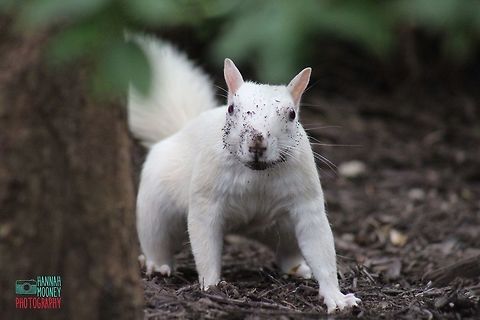
Appearance
As the name suggests, the eastern gray squirrel has predominantly gray fur, but it can have a brownish color. It has a usual white underside as compared to the typical brownish-orange underside of the fox squirrel. It has a large bushy tail. Particularly in urban situations where the risk of predation is reduced, both white – and black-colored individuals are quite often found. The melanistic form, which is almost entirely black, is predominant in certain populations and in certain geographic areas, such as in large parts of southeastern Canada. Genetic variations within these include individuals with black tails and black-colored squirrels with white tails.The head and body length is from 23 to 30 cm, the tail from 19 to 25 cm, and the adult weight varies between 400 and 600 g.
The tracks of an eastern gray squirrel are difficult to distinguish from the related fox squirrel and Abert's squirrel, though the latter's range is almost entirely different from the gray's. Like all squirrels, the eastern gray shows four toes on the front feet and five on the hind feet. The hind foot-pad is often not visible in the track. When bounding or moving at speed, the front foot tracks will be behind the hind foot tracks. The bounding stride can be two to three feet long.
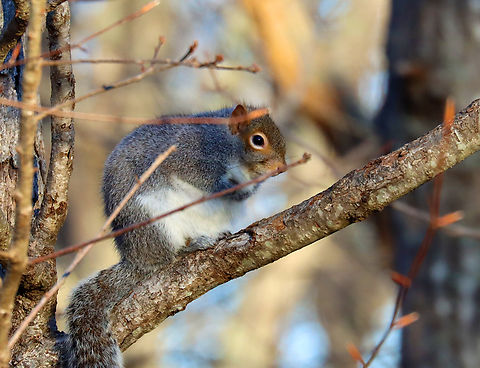
Naming
The generic name, "Sciurus", is derived from two Greek words, "skia", meaning shadow, and "oura", meaning tail. This name alludes to the squirrel sitting in the shadow of its tail. The specific epithet, "carolinensis", refers to the Carolinas, where the species was first recorded and where the animal is still extremely common. In the United Kingdom and Canada, it is simply referred to as the "grey squirrel".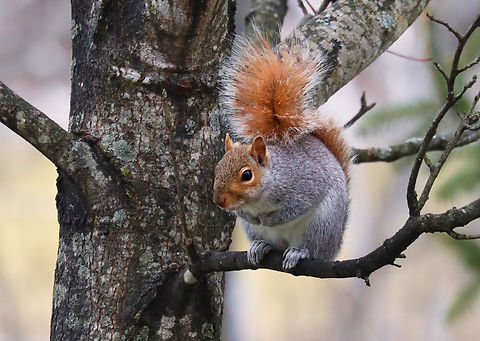
Distribution
"Sciurus carolinensis" is native to the eastern and midwestern United States, and to the southerly portions of the eastern provinces of Canada. The native range of the eastern gray squirrel overlaps with that of the fox squirrel, with which it is sometimes confused, although the core of the fox squirrel's range is slightly more to the west. The eastern gray squirrel is found from New Brunswick to Manitoba, south to East Texas and Florida. Breeding eastern gray squirrels are found in Nova Scotia, but whether this population was introduced or came from natural range expansion is not known. It has also been introduced into Ireland, Britain, Italy, South Africa, and Australia. Eastern grey squirrels in Europe are a concern because they have displaced some of the native squirrels there.A prolific and adaptable species, the eastern gray squirrel has been introduced to, and thrives in, several regions of the western United States. The gray squirrel is an invasive species in Britain; it has spread across the country and has largely displaced the native red squirrel, "S. vulgaris". In Ireland, the red squirrel has been displaced in several eastern counties, though it still remains common in the south and west of the country. That such displacement might happen in Italy is of concern, and gray squirrels might spread from Italy to other parts of mainland Europe.
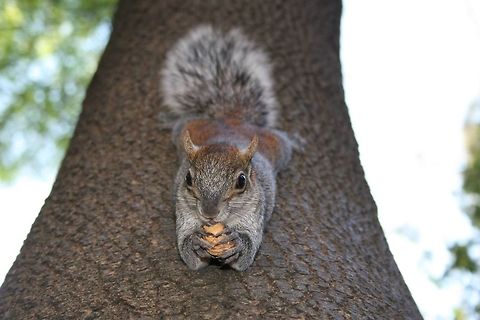
Behavior
Like many members of the family Sciuridae, the eastern gray squirrel is a scatter-hoarder; it hoards food in numerous small caches for later recovery. Some caches are quite temporary, especially those made near the site of a sudden abundance of food which can be retrieved within hours or days for reburial in a more secure site. Others are more permanent and are not retrieved until months later. Each squirrel is estimated to make several thousand caches each season. The squirrels have very accurate spatial memory for the locations of these caches, and use distant and nearby landmarks to retrieve them. Smell is used partly to uncover food caches, and also to find food in other squirrels' caches. Scent can be unreliable when the ground is too dry or covered in snow.Squirrels sometimes use deceptive behavior to prevent other animals from retrieving cached food. They will pretend to bury the object if they feel that they are being watched. They do this by preparing the spot as usual, for instance digging a hole or widening a crack, miming the placement of the food, while actually concealing it in their mouths, and then covering up the "cache" as if they had deposited the object. They also hide behind vegetation while burying food or hide it high up in trees. Such a complex repertoire suggests that the behaviors are not innate, and imply theory of mind thinking.
The eastern gray squirrel is one of very few mammalian species that can descend a tree head-first. It does this by turning its feet so the claws of its hind paws are backward-pointing and can grip the tree bark.
Eastern gray squirrels build a type of nest, known as a drey, in the forks of trees, consisting mainly of dry leaves and twigs. Males and females may share the same nest for short times during the breeding season, and during cold winter spells, squirrels may share a drey to stay warm. They may also nest in the attic or exterior walls of a house, where they may be regarded as pests, and as fire hazards due to their habit of gnawing on electrical cables. In addition, squirrels may inhabit a permanent tree den hollowed out in the trunk or a large branch of a tree.
Eastern gray squirrels are crepuscular, or more active during the early and late hours of the day, and tend to avoid the heat in the middle of a summer day. They do not hibernate.As in most other mammals, communication among eastern gray squirrel individuals involves both vocalizations and posturing. The species has a quite varied repertoire of vocalizations, including a squeak similar to that of a mouse, a low-pitched noise, a chatter, and a raspy "mehr mehr mehr". Other methods of communication include tail-flicking and other gestures, including facial expressions. Tail flicking and the "kuk" or "quaa" call are used to ward off and warn other squirrels about predators, as well as to announce when a predator is leaving the area. Squirrels also make an affectionate coo-purring sound that biologists call the "muk-muk" sound. This is used as a contact sound between a mother and her kits and in adulthood, by the male when he courts the female during mating season.
The use of vocal and visual communication has been shown to vary by location, based on elements such as noise pollution and the amount of open space. For instance, populations living in large cities generally rely more on the visual signals, due to the generally louder environment with more areas without much visual restriction. However, in heavily wooded areas, vocal signals are used more often due to the presence of less noise and a dense canopy restricting visual range.
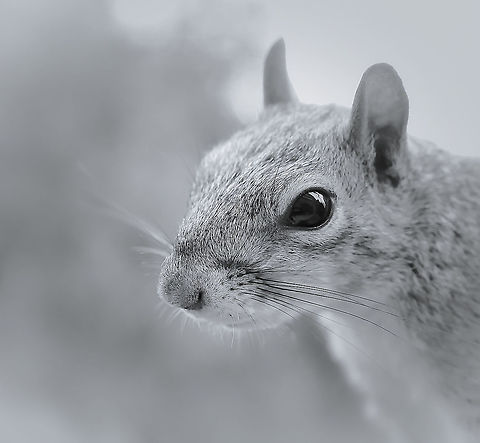
Habitat
In the wild, eastern gray squirrels can be found inhabiting large areas of mature, dense woodland ecosystems, generally covering 100 acres of land. These forests usually contain large amounts of dense understory vegetation that provides them sufficient amount of food sources and favorable shelters. Oak-hickory hardwood forests are preferred over coniferous forests.Eastern gray squirrels generally prefer constructing their dens upon large tree branches and within the hollow trunks of trees. They also have been known to take shelter within abandoned bird nests. The dens are usually lined with moss plants, thistledown, dried grass, and feathers. These perhaps provide and assist in the insulation of the den, used to reduce heat loss. A cover to the den is usually built afterwards.
Close to human settlements, eastern gray squirrels are found in parks and back yards of houses within urban environments and in the farmlands of rural environments.
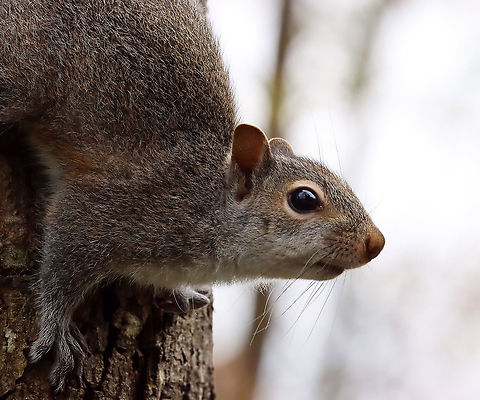
Reproduction
Eastern gray squirrels can breed twice a year, but younger and less experienced mothers normally have a single litter per year in the spring. Depending on forage availability, older and more experienced females may breed again in summer. In a year of abundant food, 36% of females bear two litters, but none will do so in a year of poor food. Their breeding seasons are December to February and May to June, though this is slightly delayed in more northern latitudes. The first litter is born in February or March, the second in June or July, though, again, bearing may be advanced or delayed by a few weeks depending on climate, temperature, and forage availability. In any given breeding season, an average of 61 – 66% of females bear young. If a female fails to conceive or loses her young to unusually cold weather or predation, she re-enters estrus and has a later litter.Normally, one to four young are born in each litter, but the largest possible litter size is eight. The gestation period is about 44 days. The young are weaned around 10 weeks, though some may wean up to six weeks later in the wild. They begin to leave the nest after 12 weeks, with autumn born young often wintering with their mother. Only one in four squirrel kits survives to one year of age, with mortality around 55% for the following year. Mortality rates then decrease to around 30% for following years until they increase sharply at eight years of age.
Eastern gray females can rarely enter estrus as early as five and a half months old, but females are not normally fertile before at least one year of age. Their mean age of first estrus is 1.25 years. Male eastern grays are sexually mature between one and two years of age. These squirrels can live to be 20 years old in captivity, but in the wild live much shorter lives due to predation and the challenges of their habitat.
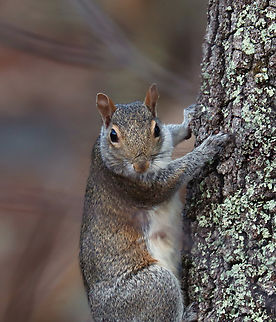
Food
Eastern gray squirrels eat a range of foods, such as tree bark, tree buds, berries, many types of seeds and acorns, walnuts, and other nuts, and some types of fungi found in the forests, including fly agaric mushrooms. They can cause damage by tearing the tree bark and eating the soft cambial tissue underneath. In Europe, sycamore and beech suffer the greatest damage.Eastern gray squirrels have a high enough tolerance for humans to inhabit residential neighborhoods and raid bird feeders for millet, corn, and sunflower seeds. Some people who feed and watch birds for entertainment also intentionally feed seeds and nuts to the squirrels for the same reason. The squirrels also raid gardens for tomatoes, corn, strawberries, and other garden crops. Sometimes they eat the tomato seeds and discard the rest. On very rare occasions, when their usual food sources are scarce, eastern gray squirrels also prey upon insects, frogs, small rodents including other squirrels, and small birds, their eggs, and young. They also gnaw on bones, antlers, and turtle shells – likely as a source of minerals scarce in their normal diet.Gray squirrels were eaten in earlier times by Native Americans and their meat is still popular with hunters across most of their range in North America. Today, it is still available for human consumption and is occasionally sold in the United Kingdom.
References:
Some text fragments are auto parsed from Wikipedia.